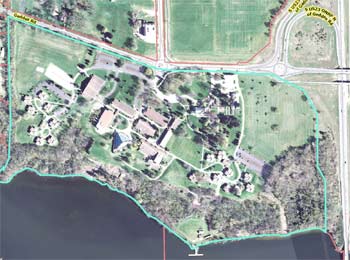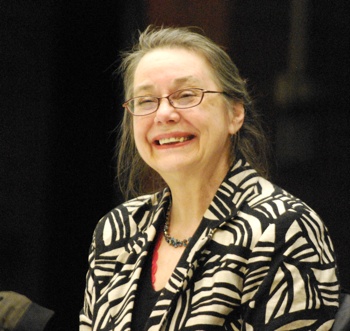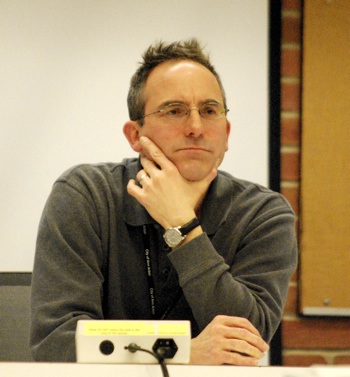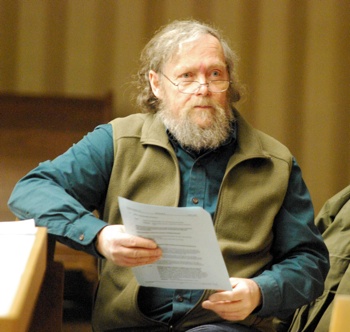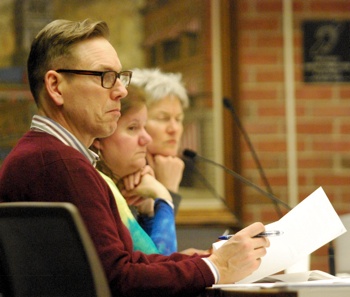Concordia Takes Step in Campus Upgrade
Ann Arbor planning commission meeting (March 4, 2014): A gym addition at Concordia University in Ann Arbor is moving forward, following action by planning commissioners to recommend approval of the project’s site plan.
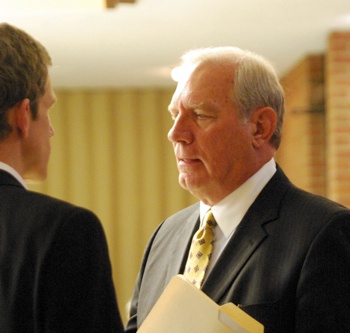
Curt Gielow (right), campus chief executive for Concordia University Ann Arbor, talks with Ann Arbor planning commission chair Kirk Westphal before the commission’s March 4, 2014 meeting. (Photos by the writer.)
The project signals a larger effort to double the size of the current institution’s enrollment of 740 students and return Concordia – which was near bankruptcy in recent years – to financial stability.
Curt Gielow, Concordia University Ann Arbor’s CEO, told commissioners that because of its distressed financial state, the Ann Arbor campus was absorbed by Concordia University Wisconsin last year. Plans are in place to invest between $10 million to $20 million in the coming years on a variety of improvements, he said.
Gielow estimated Concordia’s economic impact on Ann Arbor is in excess of $10 million annually. “I don’t think anybody wants this university to close.”
The 187-acre campus is located at 4090 Geddes Road, just west of US-23 and north of the Huron River. The Ann Arbor campus is one of the smallest of the 10 Concordias nationwide, which all are owned by the Lutheran Church – Missouri Synod. The LCMS Michigan district offices are located near the Ann Arbor campus, at 3773 Geddes.
The site plan will now be forwarded to the city council for consideration. Planning commissioners also granted a special exception use for the project, because the private university is located on a site zoned R1B (single-family residential district). No additional city council approval is required for that.
In other action, commissioners voted to support a resolution passed by the city’s energy commission and environmental commission, recommending that the city fill a vacant full-time position to focus on implementing Ann Arbor’s climate action plan.
During the March 4 meeting, energy commission chair Wayne Appleyard explained the rationale behind the recommendation, noting that one of two positions in the energy office has been vacant for about two years. While the office has been short-staffed, he said, climate change continues. “Greenhouse gases are cumulative, so the faster we can move to reduce our greenhouse gas emissions, the better off everybody’s going to be.”
Near the end of the meeting, planning commissioner Diane Giannola announced that she and Bonnie Bona would be bringing a resolution forward on March 18 related to the Library Lane site. At recent city council meetings, she noted, there has been discussion about potentially selling the air rights for the Library Lane underground parking structure to a developer. So the resolution would describe the kinds of uses that the planning commission would like to see on top of that site, she said. Giannola likened it to a similar resolution that the planning commission passed prior to the sale of the former Y lot.
Concordia University Gym Expansion
A site plan to expand the existing Concordia University gym was on the March 4 agenda. The plan also includes reconfiguring nearby parking lots and stormwater management features on the 187-acre site at 4090 Geddes Road, just west of US-23 and north of the Huron River.
As a separate item, planning commissioners were asked to grant a special exception use for the project. That’s required because the private university is located on a site zoned R1B (single-family residential district).
The site plan requires city council approval, but the special exception use does not.
The proposal calls for a three-story, 34,391-square-foot addition to the current 22,021-square-foot gym that was built in the early 1960s, located on the west side of Concordia’s main campus. [.pdf of campus map] The addition will include men’s and women’s locker rooms, athletic office space, classrooms and an auxiliary gym. A second phase of the project entails constructing a single-story, 5,280-square-foot athletic training room.
An existing gravel parking area west of the gym will be paved and landscaped, and another lot north of the gym along Geddes will get new landscaping and bioswales. A total of 92 new parking spaces will be created, mostly in the former gravel lot. A new stormwater management system will be completed to address a 100-year storm event, including a detention pond with an outlet into a bioswale south of the developed area.
The site plan is for a planned project, which allows variations in height and placement. The proposed addition would be 39 feet high. The site’s zoning has a height limit of 30 feet. The existing gym is about 33 feet high, measured at the midpoint of the roof.
Concordia is located in Ward 2. A letter from the university stated that a citizens participation meeting for the project was held on Dec. 10, 2013. The only resident who attended was Ward 2 councilmember Jane Lumm, who had no concerns about the project, according to the letter.
In giving the staff report, city planner Jeff Kahan provided a brief history of the university. It was dedicated in 1963 as a community college, and became a four-year college in 1976. Concordia became a university in 2001. The main campus is located south of Geddes, with athletic fields north of that road.
Planning staff recommended approval of the site plan and special exception use.
Concordia University Gym Expansion: Public Hearing
Curt Gielow introduced himself as Concordia University Ann Arbor’s campus CEO. He’s lived here for six months, moving to Ann Arbor from Wisconsin. Concordia in Ann Arbor is one of 10 Concordias in the country, he said. Other locations include Portland, Ore., Texas, southern California, the Bronx, Nebraska and Alabama. Concordia Wisconsin is the largest, with a student population of 8,000 in the small town of Mequon, north of Milwaukee. Gielow noted that he previously served as mayor of Mequon.
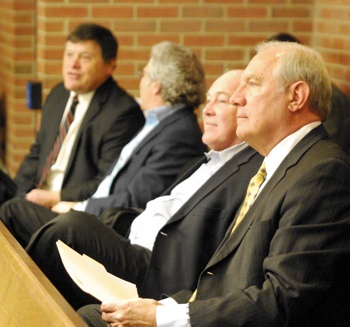
Members of the staff and design team for the Concordia University project. In the foreground is Curt Gielow, CEO of the Ann Arbor campus.
The Ann Arbor campus is one of the smallest of the 10 Concordias, which all are owned by the Lutheran Church – Missouri Synod.
The Ann Arbor campus is 50 years old, with three schools – business, education, and arts & sciences. Recently the campus has struggled financially, and within the last few years was near bankruptcy and closure, Gielow said. The church didn’t want that to happen, he added, because it felt there was a mission here. So church officials asked Concordia Wisconsin for a “helping hand,” he said.
Collaborations began a couple of years ago, culminating in a merger. So now the Ann Arbor campus is part of Concordia Wisconsin. So it’s one university with campuses in Ann Arbor and Wisconsin. Concordia’s Ann Arbor campus employs 110 people.
In the next few years, $10 million to $20 million will be invested in infrastructure and operating support to make the Ann Arbor campus viable, Gielow said. Today, there are 740 students and that’s not viable. They need to at least double their student enrollment over the next few years, he told commissioners.
Gielow said he previously served as dean of the School of Pharmacy at Concordia Wisconsin, and he was asked to come to Ann Arbor to be campus CEO. He’s been here since August of 2013. “We’ve got to be vigorous in our efforts to grow this university to a sustainable level,” he said. The projects that Concordia will bring before the planning commission in the next few years will focus on that need to grow. The campus needs to have between 1,200 to 1,400 students, he said, because it’s a tuition-driven operation. The campus gets no state or federal support – only tuition and donations.
Of the 740 current students, about 500 live on campus in 16 small dormitories that each house 32 students. “We think the economic impact of this university and sustaining this university in Ann Arbor is easily in excess of $10 million a year,” Gielow said. So he hoped that the city would allow Concordia to do the necessary things to grow.
As for the current project, Gielow said the addition to the gym would be built to match the look of the existing building. It’s not their intent to disrupt the neighbors, he said, and he thought there was unanimous support from neighbors for this effort. It won’t include any additional traffic. “I don’t think anybody wants this university to close,” Gielow said.
Cliff Mayer, the project’s architect, told commissioners that his firm has been working with Concordia Wisconsin for about 15 years. He noted that because the Ann Arbor campus was built in 1963, “everything that needs repair and replacement also goes [needs repair] at the same time.” They’re trying to be strategic about the work. The gym will be energy efficient, he said. He noted that his firm has saved the university’s Wisconsin campus $110,000 in annual energy costs through energy efficient construction, including well-insulated walls and state-of-the-art mechanical systems. It’s similar to the investments that will be made in Ann Arbor, he said. Mayer concluded by saying he was on hand to answer any questions.
Concordia University Gym Expansion: Commission Discussion
Sabra Briere asked about the anticipated growth of the campus, and wondered if the university will eventually build more dormitories. She also wanted to know if there would be more traffic because of the future expansion.
Curt Gielow reported that the existing dormitories are not full, so there’s some ability to take more on-campus students. He noted that in 2006-2007, the campus had about 1,100 students. Some students are commuters. “We just don’t know the mix of our new student base,” he said. For example, the campus is looking to grow its international student population, who would need housing.
Gielow noted that in the future, they might need to build another dormitory on campus. Much of the 187 acres that Concordia owns is available for growth, he said. “We have the significant advantage of space – and beautiful space on a beautiful river.”
He also reported that on the north side of Geddes, a football field is under construction now. Right now, Concordia plays its football games at Eastern Michigan University’s stadium and at Huron High School.
Bonnie Bona said she was very supportive of this project. She noted that she was raised in the Lutheran Church – Missouri Synod, and knows that the state offices are “across the road.” [The LCMS Michigan district offices are located at 3773 Geddes.]
Bona’s father worked for an organization called Creative Buildings out of Champaign-Urbana that built many Lutheran structures in the early 1960s, she said, so she particularly likes the architecture of these buildings.
Bona suggested that the city would be interested in working with Concordia’s Ann Arbor campus in its long-term master planning, rather than just responding to projects as they come up. It would be helpful for the community to give feedback on Concordia’s master plans, she said. Gielow indicated that Concordia would be happy to share its master planning with the city.
It’s important to integrate the campus with the city, as well as with the adjacent neighbors, Bona said, though there’s not a lot of development in that area.
Noting that Gielow had talked about getting Concordia to a sustainable level, Bona wondered how he would define that. “When we make money instead of losing it,” Gielow replied. This year, they’ll lose $3 million, he said, and Concordia Wisconsin won’t sustain those kinds of losses. So the emphasis is on growing student enrollment and courses. For example, he pointed to outreach centers in Frankenmuth and Dearborn as efforts to recruit adult students who want to complete college.
Gielow noted that because of a connection his son had, Gov. Rick Snyder had met with Concordia officials. Snyder is interested in early childhood education and nursing, Gielow said. Concordia can provide degree completion for RNs who want to get BSN degrees.
Gielow also reported that he’s talked with Washtenaw Community College about possible collaboration. WCC would like to see its students with associate degrees move on and get bachelor degrees, he said, and Concordia can help with that. So Concordia is doing outreach, Gielow said, but in the short term, the campus needs to stop losing money.
Bona then asked about parking. The zoning requires a minimum of 140 spaces – or five per classroom. There are currently 481 spaces, with plans to increase that number to 573. Cliff Mayer, the project’s architect, said that they’re not actually adding any parking. They’re just upgrading the gravel lot to the city’s standard of an asphalt lot, with bioswales and landscaping.
Bona wondered if the parking was primarily to accommodate visitors for athletic events. Mayer indicated that there’s sufficient parking for current needs, as well as to support some future growth. He noted that an additional gravel area is located on the north side of Geddes, next to the athletic field.
Bona then asked whether there’s any accommodation on campus for buses. She thought there might be opportunity to encourage more use of public transit. Gielow replied that he’s been talking to the Ann Arbor Area Transportation Authority about bringing a bus stop onto the campus. There’s an existing stop nearby on the north side of Geddes. He noted that if more students take the bus, the campus would have less need for parking.
Bona suggested that the campus might be a good location for a Zipcar.
Concordia University is a significant asset to the community, Bona said, so she’d support this project.
Ken Clein wondered whether the city should talk to the university about rezoning the site, rather than having to grant a special exception use for each project. City planner Jeff Kahan replied that this is how the city handles private colleges. Such uses are allowed by special exception in office districts and single-family residential districts. Kahan said the city staff believes the existing zoning is reasonable, and it’s reasonable to require that the university request a special exception use for each project.
Clein asked about the building materials. Mayer indicated that the intent is to match and complement the shingles on the addition’s roof with the existing gym. They’re looking at a steel shingle with granules on it that complements the “architectural ambiance of the ’60s,” he said. Right now, it’s a cost consideration, however. Clein noted that in life-cycle costs, the steel shingles would be cheaper. Mayer agreed, but said it was a matter of budget priorities within the context of all the work that needs to be done.
Clein replied that in terms of the city’s sustainability efforts, a steel shingle would go over well. Mayer quipped: “Is there any funding available?”
Clein also clarified with Mayer that the gym’s mechanicals will be going in the lower level, and any rooftop mechanicals will be screened. In response to another query, Mayer said the construction follows LEED principles, including high energy-efficiency wall systems, insulated windows, solar orientation and other features. But Concordia won’t necessarily go through the expensive process of getting LEED certified, he said.
Responding to a question from Kirk Westphal, Mayer noted that the auxiliary gym will be using natural light to lower the need for lighting during the day. It doesn’t face “dead south,” he said, but that’s not really necessary for this purpose.
Westphal asked Kahan to describe the environmental impact of paving the gravel parking lot. Kahan replied that the existing gravel surface, which has been compacted for years, has about the same runoff coefficient as asphalt. Constructing a new parking area that includes bioswales, landscaping and detention is a net positive for that site, Kahan said.
Outcome: In separate votes, planning commissioners recommended approval of the site plan and authorized a special exception use for the project. The site plan will be forwarded to city council for consideration.
Staffing for Energy Office
City planner Jeff Kahan gave the staff report, noting that at the planning commission’s Feb. 20, 2014 meeting, chair Kirk Westphal had distributed a copy of a resolution passed by the city’s energy commission. It supports a recommendation to hire a full-time employee to focus on projects that help achieve goals in the city’s climate action plan. [.pdf of resolution]
The energy commission has requested that the planning commission support this resolution. An identical resolution was adopted by the city’s environmental commission on Feb. 27.
Kahan reported that the planning commission’s bylaws give guidance on this type of request. He pointed to two specific sections:
Article III. Purpose, Objectives, and Duties
…
Section 3. The Commission shall advise City Council on matters relating to the physical and environmental development of the City. Its recommendations shall consider the impact which such development shall have on the physical, social, economic, and environmental condition of the City.
…
Article V. Ethics and Conflicts of Interest
…
Section 11. The Commission or its individual members shall not intrude into the management of the City Planning and Development Services Unit or into those matters which are handled administratively within the service unit.
Kahan listed two options that the planning commission might consider: (1) adopting the same resolution that’s been passed by the energy and environmental commissions; or (2) passing a resolution of support.
It was the latter option that planning commissioners pursued:
The Ann Arbor City Planning Commission hereby supports the Energy Commission and Environmental Commission’s efforts to identify resourcing for the City’s community energy efficiency initiatives.
Staffing for Energy Office: Public Hearing
The only speaker for the public hearing on this item was Wayne Appleyard, chair of the city’s energy commission.
Appleyard gave some background for this effort. Until two years ago, there had been two positions in the energy office. But the previous energy programs manager, Andrew Brix, left his job two years ago. That position remained vacant until earlier this year, when Nate Geisler, who’s been the city’s energy programs associate, was promoted to manager.
So the energy office is still short-staffed, Appleyard said, with an opening now for the energy programs associate.
On Dec. 17, 2012, the Ann Arbor city council unanimously adopted a climate action plan for the city. It states that the city should move very quickly to reduce greenhouse gas emissions, Appleyard said. Because municipal government operations only account for about 1.2% of total emissions in the city, the plan “requires a lot of work out in the community, and we need that second position filled in order to do that,” he said.
Climate change doesn’t wait, Appleyard added. “Greenhouse gases are cumulative, so the faster we can move to reduce our greenhouse gas emissions, the better off everybody’s going to be.”
He told commissioners that he was available to answer any questions.
Staffing for Energy Office: Commission Discussion
Bonnie Bona asked about the role of the open position. Prior to the period when one of the two energy office positions was vacant, had there been much outreach done to the community regarding greenhouse gas reduction? Wayne Appleyard said the energy office has always reached out to the community through events like the annual Green Fair, “but nothing really extensive.”
Appleyard noted that work has been ongoing, even though the office has been short-staffed for two years. But that’s primarily because the office has received grants to hire outside help. For example, the city’s property assessed clean energy (PACE) program – a financing program for energy efficiency projects on commercial properties – was only completed because the city used grant funding to hire an outside contractor. [That contractor was the Clean Energy Coalition (CEC), where Bona is employed.]
The climate action plan was just being developed when Andrew Brix left, Appleyard said. Again, grant funding allowed for the city to contract with the CEC to help move that plan forward. But a lot of work hasn’t been completed, he noted. For example, there’s an extensive appendix for the climate action plan that hasn’t yet been finished.
Bona clarified with Appleyard that the second position wasn’t eliminated by the city, but it just hadn’t been filled. Why wasn’t it filled when Brix left?
Sabra Briere speculated that it might be because the city left the position vacant in order to save money. “One way we have reduced the size of city government is through attrition,” she said.
Bona pointed out that the city had actually interviewed for the opening. That’s correct, Appleyard said. The city had interviewed candidates for the job and offered it to someone who ultimately decided not to take it. The job was then offered to another person, who also declined. At that point, he said, the process came to a halt and there was discussion about redefining the roles of the two positions.
Bona asked what would happen if the position was left vacant, and the city couldn’t pro-actively work on items in the climate action plan. Is there any way for the private sector to fill in, or is it something that only the city can do?
Appleyard replied by saying that over the past several years, the energy office has brought in over $600,000 in grant funding. “So it pays for itself, quite often,” he said. The problem with relying on grants and outside staffing is that it comes and goes, he added. The climate action plan is very ambitious and not easy to implement. “You don’t want to have boom-and-bust cycles of personnel,” he said. It’s essential to have consistent, ongoing staffing. He noted that when the office is short-staffed, some grant opportunities are missed.
Leaving the position vacant for financial reasons is shortsighted, Appleyard argued. He said that increasing energy efficiency in the community frees up money to spend on other things. When you buy electricity or natural gas, the money goes to businesses outside of the community, he said. But if residents are more energy efficient, they have more money to spend in this community. “All in all, it keeps a more vibrant community,” he said.
It’s also important to realize that with the effects of climate change, Appleyard said, “the more we can do to sort of hunker down, the better off we’ll be able to weather some of the problems that are happening.” Filling the second position in the energy office is important for that, too, he said.
A lot of people in the community are working on energy efficiency issues, in collaboration with the city, Appleyard said. A group called the Community Climate Partnership – which includes the nonprofit Ecology Center, some city staff, and energy commission members – are working on some of these issues, he said. [The Community Climate Partnership was awarded a $55,000 grant by the Funders' Network last fall. The project's description was "to build a Community Climate Partnership that brings together a cross-section of the community to implement the city’s Climate Action Plan and fosters broader community involvement and civic action around climate change."]
Appleyard noted that the work requires staff who are designated for these projects, not just volunteers.
Kirk Westphal said he didn’t recall that the planning commission has ever given formal advice on staffing issues. He said he didn’t have the wherewithal to know if this was the best use of resources at the city. Noting that the planning unit could use more staff, Westphal observed that the planning commission’s bylaws prevent it from advocating for staff within the planning unit. He said he was comfortable with the resolution of support, because it cuts across many of the goals in the climate action plan and sustainability framework. Promoting energy-efficient buildings might be the most efficient way to put money into residents’ pockets, he said.
Ken Clein noted that one of the premiums offered to developments in the downtown zoning districts relates to energy efficiency. There are also discussions about solar access, related to zoning. So it would be very helpful to have staff with relevant technical abilities to assist the commission and council in making decisions about energy-efficiency issues, he said. It would benefit developers as well as residents, he added.
In response to a query from Paras Parekh, Appleyard noted that the budget for the city’s next fiscal year – starting July 1, 2014 – is now being developed. If the vacant position is not filled, he said, then maybe it won’t be included in that budget.
Diane Giannola asked whether the planning commission, by passing this resolution, would be intruding into the management of its service unit – thereby violating its bylaws. Kahan clarified that the energy office is part of the city’s systems planning unit, not the planning and development services unit.
Bona pointed out that in order to make a recommendation of approval for this resolution, it needed six votes. She observed that only six of the nine planning commissioners were present. So to pass, it would need an affirmative vote from all commissioners who were present. [Absent were Eleanore Adenekan, Jeremy Peters and Wendy Woods.]
Bona said the most compelling aspect of the resolution is the urgency of the climate situation. These kinds of efforts take a long time to build momentum, she said. Citing the city’s PACE program, Bona called it a “real squandering of resources” to not keep programs running. It’s not just energy efficiency, she said, it’s financial efficiency.
If the city is at all serious about its climate action plan or sustainability, “this is the least we can do,” Bona said. “It’s possible that we need to do more, but let’s certainly not go backwards.”
Outcome: Commissioners voted unanimously to pass a resolution of support for hiring a full-time staff position in the city’s energy office.
After the vote, Sabra Briere – who also serves on the city council – said she’d felt uncomfortable voting on this item, because it was a request made to the council. She thought the request should be directed to the city administrator, who sets the budget. The council can amend the budget, she noted, but it would be best if the position were included by the administrator and assumed to be filled.
Communications & Commentary
Every meeting includes several opportunities for communications from planning staff and commissioners, as well as two opportunities for public commentary. Here are some highlights from March 4.
Communications & Commentary: Library Lane
Diane Giannola announced that she and Bonnie Bona would be bringing a resolution forward at the March 18 meeting related to the Library Lane site on South Fifth Avenue. At recent city council meetings, she noted, there’s been discussion about potentially selling the air rights above the Library Lane underground parking structure to a developer. So the resolution would describe the kinds of uses that the planning commission would like to see on that site, she said. Giannola likened it to a similar resolution that the planning commission passed prior to the sale of the former Y lot. [See Chronicle coverage: "Planning Group Advises Council on Y Lot."]
Sabra Briere, who also serves on city council, said she looked forward to reading the resolution, but she was concerned because the issue of the Library Lane site would likely be on the city council’s March 17 agenda. The next planning commission meeting is the following day, March 18.
Briere said that her understanding of councilmember Stephen Kunselman’s proposal is to direct the city administrator to hire a broker, and to go through the process that was done to put the former Y lot on the market. The goal of Kunselman’s resolution would be to set in motion a process to sell the air rights to the site, she said, which would allow a developer to build on it.
Giannola said that the timing would still work, because the planning commission’s resolution would be sent to council prior to any proposals for that site from developers.
Communications & Commentary: Public Commentary
Two students from Skyline High School, who are part of the school’s communication, media and public policy magnet, spoke during the first opportunity for public commentary, as part of a class assignment. They were accompanied by a third student, who did not address the commission.

Kirk Westphal and Bonnie Bona of the Ann Arbor planning commission talk to a Skyline High School student about the procedures for public commentary.
Tina Lee, a senior at Skyline, told commissioners that she’s been working with Eli Cooper, the city’s transportation program manager, on the Walk, Bike, Drive initiative. The program is designed to educate the public and make Ann Arbor more transit-oriented, bike friendly and pedestrian friendly, Lee said.
Jeremiah Clark continued the commentary, saying they’ve been working with Cooper on this program because each year, road-related deaths are increasing. According to the Centers for Disease Control, he said, road injuries account for 1.3 million deaths – or 2.3% of deaths nationwide. These incidents can be prevented if everyone follows the driving, walking, biking guidelines, he said.
Lee spoke again, noting that Ann Arbor spends $10,000 annually on the Safe Streets and Sidewalks (A2S3) campaign. It includes ads on buses, a website, vehicle stickers, media alerts and public events, she said. Even though Ann Arbor is ranked as the third-safest town in the country for pedestrians, Lee said, it’s still a problem. She urged residents to be patient, cautious and responsible “for not only ourselves, but everyone on the road. Let’s all make Ann Arbor a more walk-friendly, bike-friendly and transit-oriented city.”
Communications & Commentary: Ordinance Revisions Committee
Bonnie Bona gave a report from the planning commission’s ordinance revisions committee (ORC), which met immediately prior to the commission’s regular meeting on March 4. The focus of their work was on developing ordinance language for the downtown zoning recommendations. [See Chronicle coverage: "Council Moves on Downtown Zoning Revisions."] The first ordinance revisions that will be coming to the planning commission relate to rezoning the property at 425 S. Main – the southeast corner of Main and William. [The recommendation was to downzone the property from D1 to D2, and to establish a maximum height of 60 feet for D2 zoning in the Main Street Character District.] “We’ll keep chipping away at those recommendations, but that one was the first,” she said.
The ORC is also working on a revised version of an ordinance that regulates drive-thrus, Bona reported. It had originally been drafted in 2007, she said.
Communications & Commentary: DDA
Ken Clein, who represents the planning commission on the partnerships committee of the Ann Arbor Downtown Development Authority, reported that the DDA is kicking off its streetscape framework project, and has asked that someone on the planning commission be part of that effort. [The DDA board authorized a $200,000 contract for development of a streetscape framework plan at its Nov. 6, 2013 meeting.] Clein said that cities like San Francisco and Portland, Ore., have been successful with similar projects.
Communications & Commentary: City Commissions
Kirk Westphal, the planning commission’s chair, reported that he and Ken Clein recently met with representatives from the energy, environmental and park advisory commissions to give updates on what each of those commissions is doing, and how the work plans for these commissions relate to the city’s sustainability framework. There was interest in the planning commission’s work related to revising the downtown development premiums, he said. “That seems to be one that ties together all the commissions, and I’m sure there will be a public process around that.”
Other topics discussed at that joint meeting included a community solar project and neighborhood mini-grants, Westphal said.
Present: Bonnie Bona, Sabra Briere, Ken Clein, Diane Giannola, Paras Parekh, Kirk Westphal. Also: City planner Jeff Kahan.
Absent: Eleanore Adenekan, Jeremy Peters, Wendy Woods.
Next meeting: Tuesday, March 18, 2014 at 7 p.m. in the second floor council chambers at city hall, 301 E. Huron St., Ann Arbor. [Check Chronicle event listings to confirm date]
The Chronicle survives in part through regular voluntary subscriptions to support our coverage of publicly-funded entities like the city’s planning commission. If you’re already supporting The Chronicle, please encourage your friends, neighbors and coworkers to do the same. Click this link for details: Subscribe to The Chronicle.




